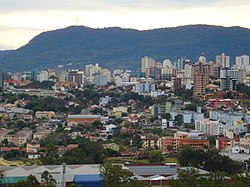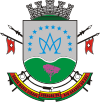Santa Maria (Rio Grande do Sul)
| Santa Maria | |||
|---|---|---|---|
| Municipality | |||
 |
|||
|
|||
 Location in Rio Grande do Sul, Brazil |
|||
| Location in Brazil | |||
| Coordinates: 29°41′0″S 53°48′0″W / 29.68333°S 53.80000°WCoordinates: 29°41′0″S 53°48′0″W / 29.68333°S 53.80000°W | |||
| Country |
|
||
| Region | South | ||
| State | Rio Grande do Sul | ||
| Government | |||
| • Mayor | Jorge Cladistone Pozzobom (PSDB) | ||
| Area | |||
| • Total | 1,823.1 km2 (703.9 sq mi) | ||
| Elevation | 113 m (371 ft) | ||
| Population (2016) | |||
| • Total | 277,309 | ||
| Time zone | UTC-3 (UTC-3) | ||
| • Summer (DST) | UTC-2 (UTC-2) | ||
| Website | santamaria.rs.gov.br | ||
Santa Maria is a municipality (município) in the central region of Rio Grande do Sul, the southernmost state of Brazil. In 2016, its population was 277,309 inhabitants in a total area of 1,823 square kilometres (704 sq mi).
The city is known for the Federal University of Santa Maria and a number of other private universities and colleges.
The city annually hosts an important Roman Catholic festival dedicated to Nossa Senhora Medianeira, called "Romaria da Medianeira" (Medianeira is a name of Our Lady that was created in Venice, Italy). Every year, hundreds of thousands of people from all over Brazil join in the celebrations.
Santa Maria is the location of the Santa Maria Air Force Base of the Brazilian Air Force, which houses four units. It is also the seat of the Roman Catholic Diocese of Santa Maria.
Santa Maria is the fifth largest city in the state of Rio Grande do Sul, after Porto Alegre, Caxias do Sul, Pelotas, and Canoas. Many of the city's inhabitants are of German and Italian ancestries.
It is the largest city in the central region of the state, concentrating 36.40% of this region's population. During the period between 2000 and 2010, Santa Maria had a demographic growth rate of 6.00%.
The municipality contains 10 districts. The city of Santa Maria itself is located in the urban Seat District (Distrito Sede), which is divided into 8 regiões administrativas (administrative regions), and further subdivided into 40 bairros (neighbourhoods). About 95% of the municipality's total population is concentrated in the Seat District. One of the districts is Palma.
...
Wikipedia



